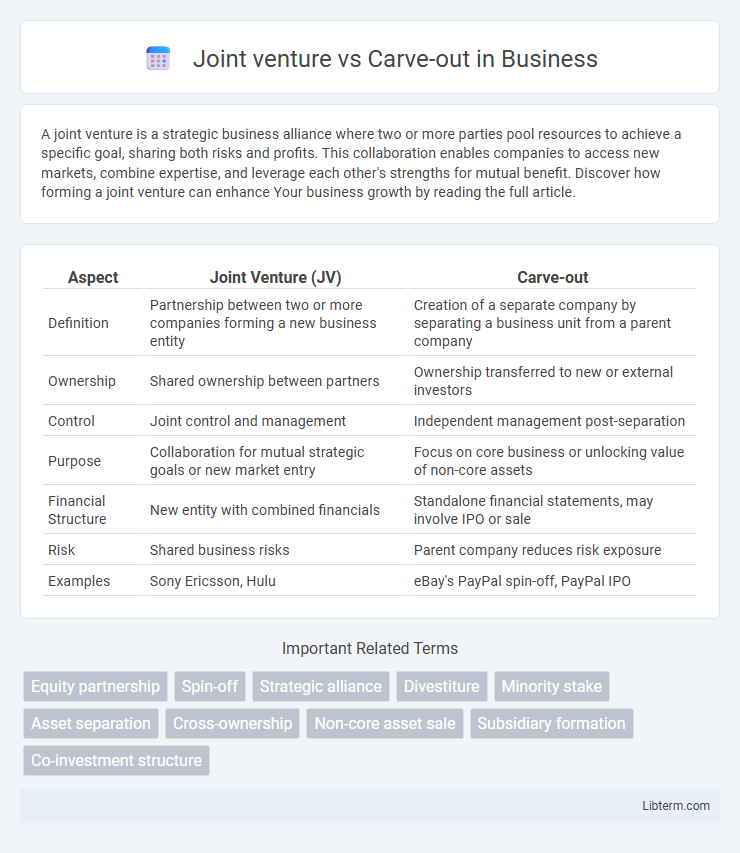A joint venture is a strategic business alliance where two or more parties pool resources to achieve a specific goal, sharing both risks and profits. This collaboration enables companies to access new markets, combine expertise, and leverage each other's strengths for mutual benefit. Discover how forming a joint venture can enhance Your business growth by reading the full article.
Table of Comparison
| Aspect | Joint Venture (JV) | Carve-out |
|---|---|---|
| Definition | Partnership between two or more companies forming a new business entity | Creation of a separate company by separating a business unit from a parent company |
| Ownership | Shared ownership between partners | Ownership transferred to new or external investors |
| Control | Joint control and management | Independent management post-separation |
| Purpose | Collaboration for mutual strategic goals or new market entry | Focus on core business or unlocking value of non-core assets |
| Financial Structure | New entity with combined financials | Standalone financial statements, may involve IPO or sale |
| Risk | Shared business risks | Parent company reduces risk exposure |
| Examples | Sony Ericsson, Hulu | eBay's PayPal spin-off, PayPal IPO |
Introduction to Joint Ventures and Carve-outs
Joint ventures involve two or more businesses collaborating to form a new entity, sharing resources, risks, and rewards for a specific project or purpose. Carve-outs refer to a company divesting a portion of its operations or assets to create a separate standalone business, often to unlock value or streamline focus. Both strategies serve different goals: joint ventures emphasize cooperation and shared investment, while carve-outs focus on organizational restructuring and asset separation.
Defining Joint Ventures: Structure and Purpose
A joint venture is a strategic alliance where two or more parties create a separate legal entity to achieve specific business objectives, sharing risks, resources, and profits. Its structure involves collaborative management and pooled assets from partners, designed to leverage complementary strengths for market expansion or innovation. The purpose centers on combining expertise and capital to pursue mutual goals while maintaining individual independence outside the joint venture.
Understanding Carve-outs: Key Characteristics
Carve-outs involve a parent company selling a minority stake of a business unit to outside investors while retaining majority control, enabling focused management and access to capital. This strategy typically unlocks value by allowing the carved-out entity to operate with greater strategic independence while still benefiting from parent company resources. Carve-outs differ from joint ventures, which are collaborative partnerships where parties share ownership and control, usually creating a new entity for a specific project or business objective.
Strategic Objectives: Why Companies Choose Each
Joint ventures enable companies to pool resources and expertise to enter new markets or develop innovative products while sharing risks and costs. Carve-outs allow firms to streamline operations, unlock shareholder value, and focus on core businesses by divesting non-core assets or business units. Companies choose joint ventures for collaboration and expansion opportunities, whereas carve-outs are selected to enhance financial performance and strategic focus.
Financial Implications: Costs, Profits, and Risks
Joint ventures often require shared capital investment and ongoing operational costs, with profits and risks distributed proportionally between partners, impacting financial statements through equity method accounting. Carve-outs involve divesting a business unit, generating immediate cash influx but potentially incurring one-time separation costs and altering revenue streams and risk profiles of both the parent company and the new entity. Financial implications include changes in asset valuation, tax considerations, and potential shifts in debt structure due to varying investment and operational responsibilities in each strategy.
Governance and Decision-Making Differences
Joint ventures involve shared governance where partner companies jointly make strategic decisions through a management committee or board, ensuring equal representation and collaborative control. Carve-outs establish independent governance structures with the new entity operating under its own executive team and board, granting parent companies majority influence or control tailored to their strategic objectives. Decision-making in joint ventures emphasizes consensus among partners, while carve-outs prioritize autonomy and streamlined decisions aligned with the standalone business's goals.
Legal and Regulatory Considerations
Joint ventures require thorough due diligence on partnership agreements, regulatory compliance, and antitrust laws to ensure legal alignment between parties and jurisdictions. Carve-outs demand careful navigation of asset separation, transfer approvals, and compliance with securities regulations, especially when involving public companies or cross-border transactions. Both strategies must address intellectual property rights, employee transfer laws, and tax implications to mitigate legal risks and regulatory scrutiny.
Impact on Company Culture and Talent
Joint ventures often require blending distinct company cultures, which can foster innovation but also create challenges in aligning values and communication styles. Carve-outs involve separating a business unit, leading to a concentrated cultural shift and possible uncertainty among talent regarding future opportunities and stability. Both strategies significantly impact employee engagement and retention, necessitating deliberate cultural integration and talent management efforts.
Common Challenges and Mitigation Strategies
Joint ventures and carve-outs commonly face integration challenges, including misaligned objectives, cultural clashes, and communication barriers. Effective mitigation strategies involve establishing clear governance structures, aligning stakeholder incentives, and implementing robust change management processes. Thorough due diligence and continuous monitoring further reduce risks associated with operational disruptions and strategic missteps.
Joint Venture vs Carve-out: Which Is Right for Your Business?
Joint ventures enable businesses to pool resources and expertise, fostering innovation and shared risk, often ideal for entering new markets or developing new products. Carve-outs involve selling or spinning off a business unit, providing focused capital and operational independence to drive growth or streamline the parent company. Choosing between a joint venture and a carve-out depends on strategic goals, control preferences, and desired financial outcomes for sustainable business growth.
Joint venture Infographic

 libterm.com
libterm.com